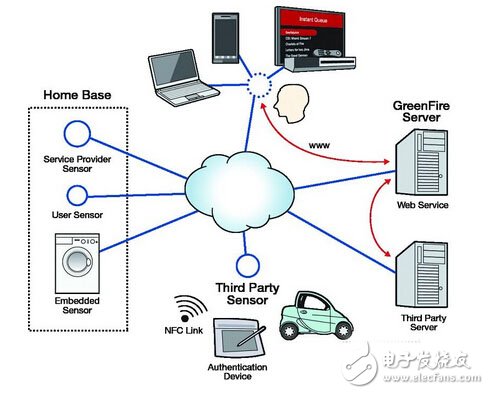At present, the application of smart grid in the contemporary is more and more extensive, and the smart grid is worth learning. Now let's take a deeper understanding of the core of the smart grid - GreenFire system.
In order to improve energy efficiency, a new form of energy accounting system called Virtual Energy Account was created to handle the power generation and consumption of individuals, households or companies. Virtual energy accounts use network technology to integrate all the information they need.
smart system
The GreenFire system includes new ways to use energy and billing. The GreenFire system consists of two elements: a sensor and a server. The sensor is responsible for measuring the power flow of the device to which it is attached. The GreenFire sensor hardware is designed with a variety of options. The most suitable is based on the design of Microsemi's SmartFusion series.
Each SmartFusion device includes an ARM Cortex-M3 microcontroller subsystem, a built-in tightly coupled field-programmable gate array (FPGA) and SRAM block, and a programmable analog block. By combining three main electronic hardware, SmartFusion is able to place the sensor into the plug and the interior of the appliance is highly integrated. Security is an inherent feature of SmartFusion devices when they are designed and manufactured.

Richard Newell, Strategic Marketing Product Plan and Architect, Microsemi
The Cortex-M3 is the processor core that ARM specifically uses to control applications. The SmartFusion Cortex-M3 and SRAM operate at 100MHz with zero latency. In each SmartFusion device, there are two independent zero-waiting embedded SRAM blocks and one embedded non-volatile flash memory block for the user. Standard hardware peripherals include a 10/100Mbp Ethernet MAC, two SPI, I2C, and UART serial ports, two 32-bit timers, and a 32-bit watchdog timer.
In the GreenFire sensor, the FPGA fabric is used to implement certain DSP algorithms, such as Fast Fourier Transform (FFT). The voltage and current of the power line are sampled and digitized by an analog to digital converter on the chip. The sample sequence uses FFT to determine certain metrics such as power factor and harmonic content. In some cases, whether the system under monitoring is normal can be judged by the analyzed parameters, and the warning can prevent potential catastrophic failures. Executing the FFT algorithm in the FGPA architecture is more time-consuming than executing in the microcontroller. In addition, a dedicated hardware FFT controller is faster and more power efficient than software that performs the same work on a general purpose microprocessor architecture.
Trusted architecture
The security features of the SmartFusion devices within the GreenFire sensor provide the root of trust for the sensor hardware. It checks the signature of the program stored in the memory accessible to the user to ensure that the program code has not been tampered with.
The use of Flash has become an important security foundation for the GreenFire system based on the SmartFusion architecture. It saves the encryption keys and certificates used on the chip to establish secure network communications. SmartFusion's built-in tamper detection circuit makes the work of intruders more difficult. To further protect the security of critical code, SmartFusion devices include a dedicated hardware-accelerated decryption engine that can be loaded securely.
Design Flow
The speed of development can be further accelerated by using conceptual model technology that is compatible with the hardware and software environments used by SmartFusion devices and GreenFire. GreenFire Workbench is designed using the MATLAB and Simulink tools released by Mathworks.
First, design a hardware descrip TIon language (HDL) that can be directly described in words, such as Verilog or VHDL. The main link library blocks, such as FFT or GPIO, are available on the Microsemi SoC product website. Microsemi also offers Mentor Graph's ModelSimVerilog and VHDL simulators for logic simulation of register transfer level (RTL) and gate level (post synthesis).
Another design approach, especially for designs that require a large number of DSPs, is to use Simulink and Synphony HLS AE DSP block link libraries and build tool plugins. Users of Microsemi FPGAs can use Synopsys tools for free, capture and simulate parametric block diagrams in Simulink, and automatically generate transformed Verilog or VHDL for downstream synthesis tools.
Once the FPGA design has generated VHDL or Verilog in one or more of the ways mentioned above, the Synopsys Synplify Pro compiler can be used to synthesize the circuit and convert the design from RTL to gate level. Then, use Libero IDE's layout and routing tools to complete the actual circuit fabrication on a particular device, including timing closure and power analysis. All that's left is to finish processing the monitoring data.
To increase efficiency, the power network must improve and become smarter. Using Internet technology, coupled with a secure, highly integrated hardware platform, can reduce energy consumption, optimize consumption, and reduce consumer costs. The GreenFire system based on Microsemi SmartFusion cSoC can be used as the basis for this new smart grid.
Ei 76 Transformer,76V Transformer,Ei-76 Transformer,Audio Output Transformer,low voltage lighting transformer
Guang Er Zhong(Zhaoqing)Electronics Co., Ltd , https://www.cnadaptor.com
